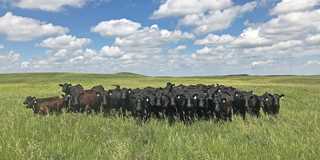By Becky Jones Mahlum and Jonas Davis
The Prairie Pothole Region is where Ducks Unlimited's vision of skies filled with waterfowl begins. Achieving that vision sometimes means adapting DU's conservation programs in response to the latest science and the interests of farmers and ranchers, who own 90 percent of the land in the region. While maintaining its successful efforts to protect intact prairie grasslands and wetlands, DU has developed innovative and flexible new programs that help improve the profitability of producers while also conserving wetlands and providing habitat for waterfowl.
A New Focus on the Prairies
Decades of research conducted by DU and its partners has confirmed that small, shallow wetlands, many of which are located in cropland, are the most important habitats for breeding waterfowl on the prairies. "Our research has revealed that if wetlands remain on the landscape, ducks can often find a way to nest successfully, even in areas with limited upland cover," says Dr. Johann Walker, DU's director of conservation programs in North Dakota, South Dakota, and Montana and a past leader of DU research programs on the prairies. "Consequently, we are expanding our conservation delivery on cultivated lands while also continuing to protect native prairie and other grasslands."
DU's successful partnership with the U.S. Fish and Wildlife Service to purchase conservation easements from private landowners has permanently protected 1.5 million acres of the "best of the best" waterfowl habitat in the U.S. portion of the Prairie Pothole Region. However, each year an estimated 50,000 acres of prairie grasslands are converted to cropland and large numbers of small wetlands are drained. Conservation easements remain highly popular among prairie landowners, but as federal funding has decreased, there simply isn't enough money to meet the demand. Today, more than 1,000 landowners are waiting for easement funding.
Wetlands located in grasslands that are managed for cattle grazing often serve as valuable water sources for livestock, so landowners have an incentive to protect them. Wetlands embedded in cropland, however, are often considered a nuisance by landowners who must farm around them. Consequently, as grassland is converted to cropland, wetlands become more vulnerable to drainage. In addition, as crop prices have improved and the use of drainage tiles has expanded across the prairies, so has the push to drain wetlands. As a result, tens of thousands of these small, shallow wetlands, which provide crucial breeding habitat for mallards, northern pintails, and other ducks, are currently at risk.
A Holistic Approach to Conservation
Ducks Unlimited has long partnered with farmers and ranchers on working agricultural lands to deliver conservation programs tailored to address landowners' needs while also benefiting the resource. However, to effectively conserve wetlands in croplands, a new, more holistic approach was needed. "We had to find additional ways to include the interests and values of people in our conservation efforts while still meeting our objectives," says Jonas Davis, DU's manager of conservation programs in North Dakota. "We focused on listening and working closely with farmers and ranchers as we developed new programs that will benefit them and conserve crucial habitat."
There is currently great interest among producers for incentive-based programs with short commitment periods that will help make their operations more resilient in these challenging times. Landowners also want assistance with some of the upfront costs associated with trying new agricultural practices. DU has responded by developing a suite of new conservation programs that help protect wetlands embedded in croplands, while also improving the profitability and sustainability of agriculture on the prairies. One of the most promising new programs is aimed at improving the health of soils in the Prairie Pothole Region.



